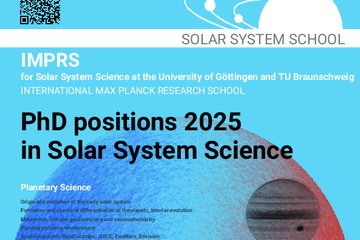All genres
61.
Talk
Pluto for planet. Planetarium Hamburg, Hamburg, Germany (2020)
62.
Talk
Extrasolare Planeten. Helene-Lange-Schule Hannover, Hannover, Germany (2020)
63.
Talk
Homing in on Earth-like planets beyond the solar system. Konkoly Observatory, Budapest, Hungary (2019)
64.
Talk
Argumented Reality @Sartorius. WORK LIFE SPACE. Sartorius Campus , Göttingen, Germany (2019)
65.
Talk
Wie findet man einen Exoplaneten? Max-Planck-Institut für Sonnensystemforschung, Göttingen, Germany (2019)
66.
Talk
Extrasolare Monde – schöne, neue Welten? Planetarium Hamburg, Hamburg, Germany (2019)
67.
Talk
On-ground Outlier Detection Algorithms Over Light Curves Using Spatial Redundancy. PLATO week 9, Marseille, France (2019)
68.
Talk
Observations of Extrasolar Planets and Formation of Planets in Protoplanetary Discs. Queen Mary University, London, UK (2019)
69.
Talk
Von Eiswelten, Vulkanhöllen und unterirdischen Ozeanen. Planetarium Hamburg, Hamburg, Germany (2019)
70.
Talk
Detecting shallow transits with smart force: the Transit Least Squares (TLS) algorithm. PLATO Extrasolar Planets 2019: Single, Shallow & Strange Transits, Warwick , UK (2019)
71.
Talk
Extrasolare Planeten. Max-Planck-Institut für Sonnensystemforschung, Schülerbesuch der 11. Klasse des Felix-Klein-Gymnasium Göttingen, Göttingen, Germany (2019)
72.
Talk
PLATO On-ground Outlier Detection Algorithm Over Imagettes. PLATO Week 8, Graz, Austria (2019)
73.
Talk
In situ-Erkundung extrasolarer Planeten Science Fiction oder Science Fact? Vortragsreihe "Extrasolare Planeten, Astrobiologie und die Frage nach Leben im Universum" der Akademie der Wissenschaften, Hamburg, Germany (2019)
74.
Talk
How to park a hot Jupiter at 0.05 AU around a sun-like star for billions of years. Planet Formation and Evolution 2019, Rostock, Germany (2019)
75.
Talk
On-ground Outlier Detection Algorithms for Imagettes and L0 Light Curves (remotely). PLATO Week 7, Cambridge, UK (2019)
76.
Talk
The Perils and Merits of Living with Tidal Heating. Heidelberg Initiative for the Origin of Life, Heidelberg, Germany (2018)
77.
Talk
Die weltraumgestützte Suche nach Exoplaneten mit Kepler und PLATO. Bundesweite WE-Heraeus-Lehrerfortbildung zur Astronomie, Heidelberg, Germany (2018)
78.
Talk
Detection of Extrasolar Moons in the Presence of Stellar Variability. PLATO ESP2018: Stellar variability and its effect on the characterisation of small planets., Marseille, France (2018)
79.
Talk
Formation of hot Jupiters through disk migration and evolving stellar tides. Astrophysikalisches Kolloquium, Georg-August-Universität Göttingen, Göttingen (2018)
80.
Talk
Deceleration of high-velocity interstellar photon sails at alpha Centauri. European Week of Astronomy and Space Science (EWASS), Liverpool (2018)











